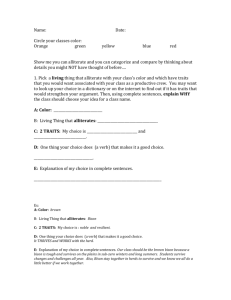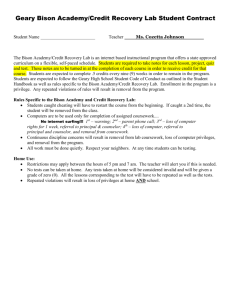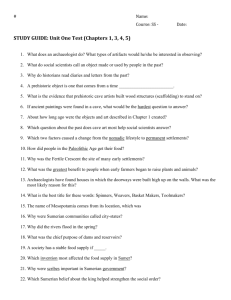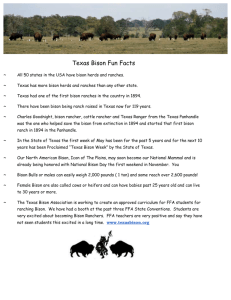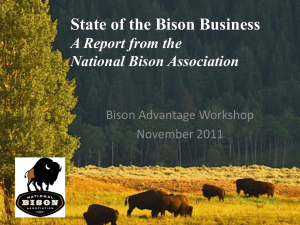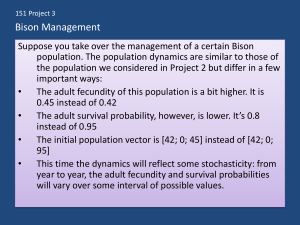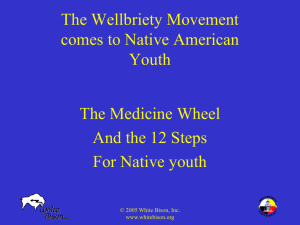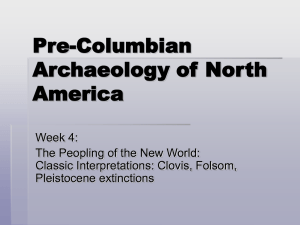Bio-Diversity, Extinction, and Incentives to Save/Exterminate Species
advertisement
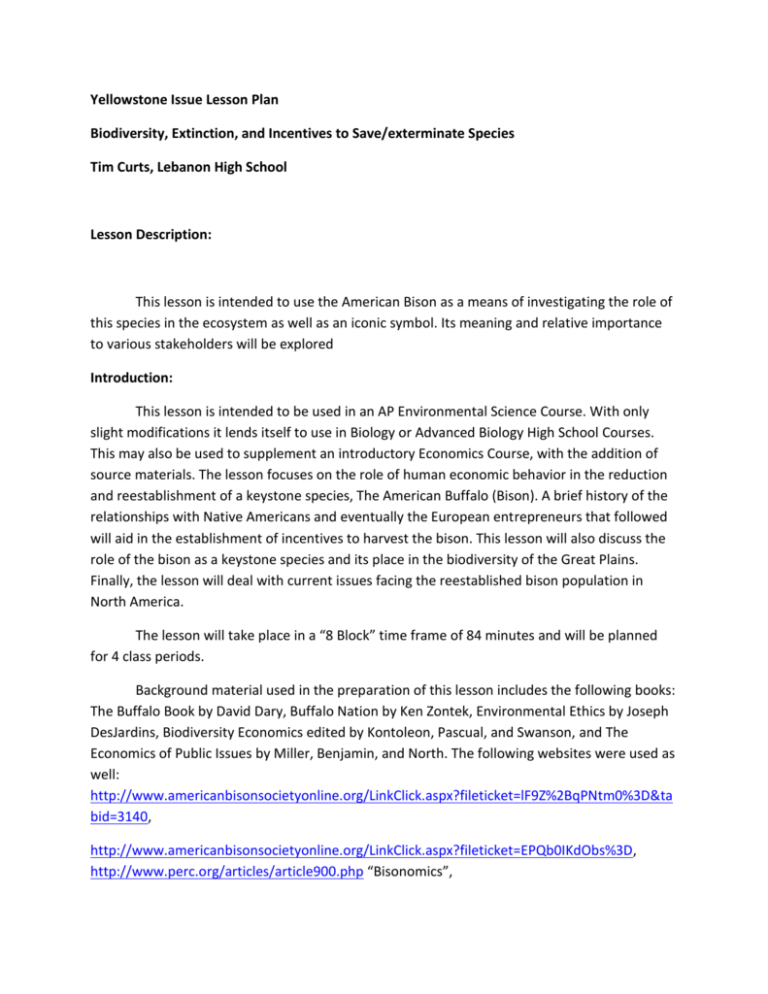
Yellowstone Issue Lesson Plan Biodiversity, Extinction, and Incentives to Save/exterminate Species Tim Curts, Lebanon High School Lesson Description: This lesson is intended to use the American Bison as a means of investigating the role of this species in the ecosystem as well as an iconic symbol. Its meaning and relative importance to various stakeholders will be explored Introduction: This lesson is intended to be used in an AP Environmental Science Course. With only slight modifications it lends itself to use in Biology or Advanced Biology High School Courses. This may also be used to supplement an introductory Economics Course, with the addition of source materials. The lesson focuses on the role of human economic behavior in the reduction and reestablishment of a keystone species, The American Buffalo (Bison). A brief history of the relationships with Native Americans and eventually the European entrepreneurs that followed will aid in the establishment of incentives to harvest the bison. This lesson will also discuss the role of the bison as a keystone species and its place in the biodiversity of the Great Plains. Finally, the lesson will deal with current issues facing the reestablished bison population in North America. The lesson will take place in a “8 Block” time frame of 84 minutes and will be planned for 4 class periods. Background material used in the preparation of this lesson includes the following books: The Buffalo Book by David Dary, Buffalo Nation by Ken Zontek, Environmental Ethics by Joseph DesJardins, Biodiversity Economics edited by Kontoleon, Pascual, and Swanson, and The Economics of Public Issues by Miller, Benjamin, and North. The following websites were used as well: http://www.americanbisonsocietyonline.org/LinkClick.aspx?fileticket=lF9Z%2BqPNtm0%3D&ta bid=3140, http://www.americanbisonsocietyonline.org/LinkClick.aspx?fileticket=EPQb0IKdObs%3D, http://www.perc.org/articles/article900.php “Bisonomics”, and http://www.buffalofieldcampaign.org/legal/esacitations/floresbisonecology.pdf “Bison Ecology and Bison Diplomacy”. Biology and APES Concepts. Biodiversity Extinction Habitat Keystone Species Ecology Tragedy of the Commons Carrying Capacity Population Density Rangeland vs Pasture Intensive Farming Environmental Ethics Conservation Biology Land Management Issues Biological Extinction Ecological Extinction Wildlife Conservation Strategies Demand Property Rights Scarce Good or Resource Common Good Content Standards Biology B.1.15, B.1.21, B.1.31, B.1.32, B.1.34, B.1.36, B.1.37, B.1.39, B.1.40, B.1.41, B.1.43, B.1.46, B.1.47 Environmental Science ENV.1.1, ENV.1.3, ENV.1.4, ENV.1.8, ENV.1.14, ENV.1.18, ENV.1.30 Economics E.1.4, E.1.7, E.1.8, E.4.9, E.4.10 Objectives The students will understand the concept of keystone species as it pertains to the biodiversity of an ecosystem. The student will also be able to identify the various reasons for extinction and analyze each one’s role in the case of the Bison. The student will discuss the status of the bison as an icon to the various peoples involved with its history The students will analyze the concept of a common property and its implications in management of the property. The students will use data to follow the natural history of the bison The student will analyze various solutions for the bison conflict for their practicality in solving the issues surrounding the bison. Lesson Plan Day 1 Begin with a presentation of PowerPoint “American Bison: Then and Now” by Tim Curts, Molly Shover, and Courtney Symons, found on the powerpoint page of this website http://www.indstate.edu/publiclanduse/Instructional%20Powerpoints.htm . The first portion of the presentation dealing with the Native Americans and bison relationships will be presented and discussed. Activities: Lesson C “Bison and Their Habitat” from www.nps.gov/tapr/forteachers/upload/American%20Bison_new-2.pdf Read pages 1-18 and do the exercise “The Trail Back from Near Extinction” from http://lawrencehallofscience.org/gss/rev/TeacherGuides-PDFs/5LB-TG.pdf Chapters 1 and 2 pgs 1-18 Day 2 Review the exercises and present the section of the power point dealing with the natural history of the bison. Activities: Do lessons E (The Early Buffalo Hunt) and F(Destruction of the Bison) from www.nps.gov/tapr/forteachers/.../American%20Bison_new-2.pdf Do Activity 1 “Extinction and Endangered Species: What Can you do?” from http://www.pbs.org/americanfieldguide/teachers/native_species/native_species_sum.html Day 3 Activities Have the students read and discuss the article “Bisonomics” located at: http://www.perc.org/articles/article900.php When they complete the article the following questions are to be discussed Describe how successful solutions for maintaining the integrity of natural systems must also address the needs of local people and should include those local communities in the planning and implementation. Describe examples of the different viewpoints local people may have about land use issues. Stress that the intent is not to be judgmental, but rather to recognize that there are usually several different perspectives for every issue. • Have students examine the pros and cons of the proposals from the different perspectives. Point out that it is important for people to work together to find long term solutions to complex resource conflicts. Invite students to suggest strategies they would use to help get different interest groups together to “buy in” Day 4 Present the final section of the power point dealing with the issues surrounding bison and particularly Yellowstone bison. Activities Have the students complete the Lesson 6 “How can We Help the Endangered Species?” found in Economics and the Environment, EcoDetectives printed 1999 ISBN 1-56183-483-1 Have the Students complete Chapter 27 “Bye, Bye Bison” and respond to the Questions on pg 169 from The Economics of Public Issues (16th Edition, 2007) by Roger Leroy Miller, Daniel K. Benjamin, Douglass C. North ISBN: 0321416104, Publisher: Addison Wesley Longman Assign the brucellosis exercise located on pages 21- 43 at http://www.americanbisonsocietyonline.org/LinkClick.aspx?fileticket=EPQb0IKdObs%3D Assign the background article “Bison Ecology and Bison Diplomacy” located at http://www.buffalofieldcampaign.org/legal/esacitations/floresbisonecology.pdf Day 5 For Final Assessment, place the students into three groups based on the proceedings of the American Bison Society. They are to present a short paper and discussion answering the following question: What would “Bison ecological restoration” look like to your stakeholder group? Using the following goals created by breakout groups from a previous American Bison Society’s annual meeting and the information from the unit, the students are to be placed in role playing groups of the same name in order to critique the importance and progress on the goals set forth by each identified group. The students will then discuss their critique with the class. Each student will provide a three to five page summation paper using their discussion and the information from the unit. The groups, goals, and complete proceedings are to found at : http://www.americanbisonsocietyonline.org/LinkClick.aspx?fileticket=lF9Z%2BqPNtm0%3D&ta bid=3140 The goals and groups for the exercise are as follows: Native American Relationship Goals One- to five-year goals: • Gather aboriginal thoughts and create a collaborative direction on ecological recovery. Prioritize traditional knowledge regarding bison. • Educate tribal members on the importance of bison; communicate the spiritual connection through education. • Assess status (genetic and other) of bison currently on tribal lands. • Identify funding for tribes that wish to put genetically pure bison on their land. • Identify major land masses that are connected and talk with landowners and communities; Create refuges for bison far from people. • Promote the idea that bison are more than just meat and justify the care of them outside economic interests. 20- to 50-year goals: • Get as close as possible to elimination of cattle genes in buffalo. • Restore traditional buffalo stories and human health. • At least 10 populations of migrating bison herds. • Tribes across North America work together to restore bison. • Minimize and eliminate transfer of disease between cattle and bison. 20- to 50-year goals (cont): • Restore native ecosystems at a large spatial scale, and support government partnership on this. Promote something inspiring (National Bison Conservation Act). • Subject conservation herds (TNC, WWF-US) to natural selection and encourage public herds to be managed this way. • Create the circumstances necessary to allow large-scale movement between herds or landscapes to preserve migratory instincts of bison. • Conduct reassessment of how we are conserving bison. • Promote a conducive, fair, and scientifically based regulatory environment. • Improve testing and veterinary tools to address disease and genetic issues. Agencies (Federal, State, Provincial) One- to five-year goals: • Genetics: Establish an agency agreement regarding genetic conservation rule (90% rule) and effectively limit cattle introgression. • Disease: Exercise due diligence in preventing spread of disease and maintain compliance with state and federal policies. • Land management: Identify high-priority sites for bison conservation/recovery on existing public lands; facilitate use of agency lands for bison recovery – change grazing policy. • Policy: o Ensure bison are on the agenda at Association of Fish Wildlife Agencies and other meetings. o Bring bison recovery issues to international trilateral commission. o Promote introduction of herds in Mexico. Promote UMAS for conservation of bison in Mexico. o Promote conservation easements for bison habitat. o Investigate how Migratory Act applies to bison that migrate to and from Mexico. Medium priorities: • Consider promoting a consistent re-classification of bison in states and nations. • To address lack of source bison that are genetically suitable and disease-free, agencies can become suppliers of known animals and establish and maintain a centralized database on movements of animals between herds. • Interagency coordination to establish a third-party bison certification (e.g., grass-fed, free-ranging); create interagency bison recovery information materials and working group; use bison as vehicle to educate the public about history, benefits, and future of bison; increase awareness and understanding of bison recovery among key agency leaders. 20- to 50-year goals: • Habitat: Grow large protected areas and/or connected landscapes that will support core herd. Investigate reclamation of areas used for coal mining/ energy development • Incentives: Establish economic incentives that permit private land owners to sustainably keep conservation/recovery bison herds. Encourage sale of grazing permits for bison. • Management: Allow harvest management that mimics natural predation on bison. • Develop education programs that address actual population demographics. Social Science Based Organizations One- to five-year goals: • Create education, awareness, and outreach programs to public and policymaking constituencies. • Resolve disease regulation issues. Identify what veterinary and policy progress needs to be made so that bison can be available to repopulate. • Promote recognition of bison as a species of common concern at the North American level by the trilateral committee and Commission for Environmental Cooperation of NAFTA. • Make progress on gaps in knowledge base – genetic, ecological impacts – prior to start of reintroduction efforts; develop socioeconomic baseline for regions of potential re-introduction. • Identify priorities by population/geographical area. Have a model site in each area that displays a majority of exemplary ecological attributes; Major bison reintroduction in at least three eco-geographical areas (currently only one in Northern Great Plains). • Communicate contribution of individual herds. • Ask for Executive Order or legislation directing federal agencies to “seamlessly manage their lands for the coordinated ecological restoration of bison on federal lands.” • Try to redirect federal incentives in Farm Bill and research incentives for private landowners. 20- to 50-year goals: • Resolve disease issues. • Trans boundary Peace Parks US-Mexico, US-Canada set aside for restoration of grassland ecosystems. • Reduce threats to grassland birds and other grassland species.
